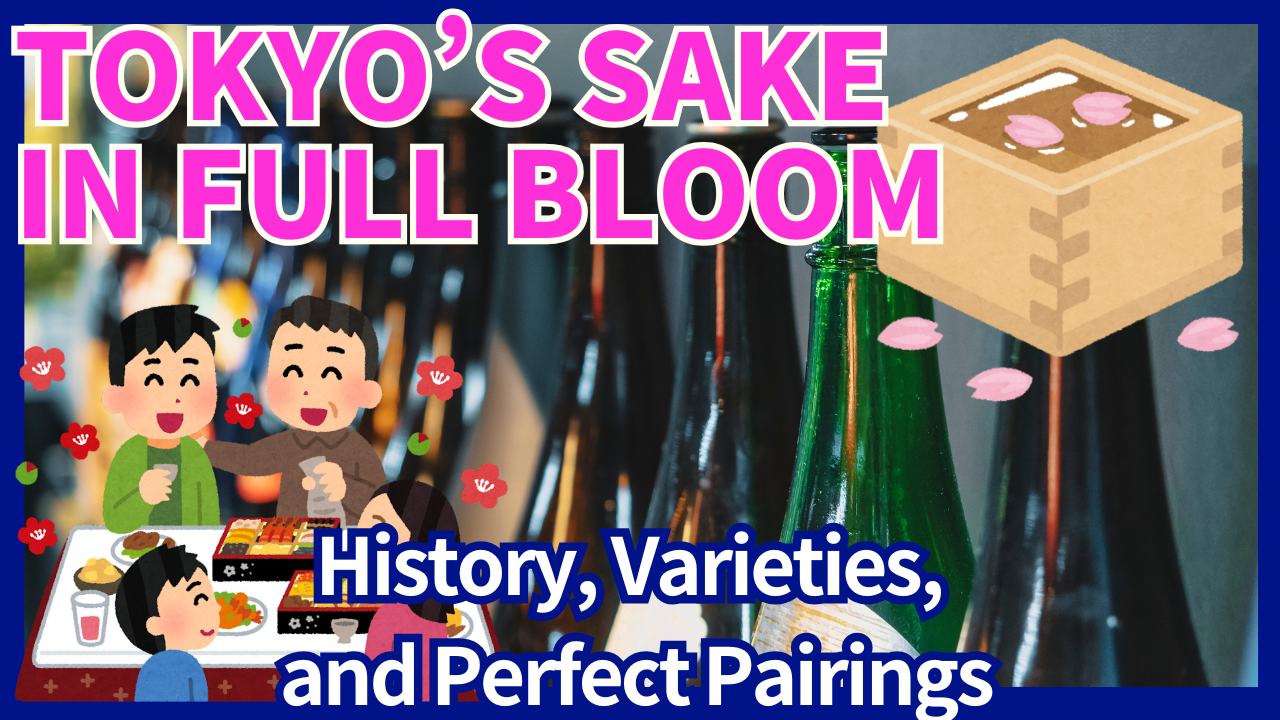- Prologue: The Allure of Spring and Sake
- From Sacred to Celebratory: A Brief History of Sake
- The Rich Varieties of Sake: Nuances and Craftsmanship
- Why Sake Complements Japanese Cuisine So Well
- Celebrated Sake Brands and Brewers Worldwide
- Enjoying Sake in Tokyo: Recommended Spots
- Conclusion: Embrace Sake Amid the Cherry Blossoms
Prologue: The Allure of Spring and Sake
Springtime in Japan arrives on the soft pink breeze of cherry blossoms. There’s nothing quite like enjoying sake under the fluttering petals.
A drink that has been used in sacred rituals since ancient times, sake is now woven into the fabric of countless seasonal events. Remember to enjoy sake responsibly, abide by the legal drinking age in your country or region, and never drink and drive.
In this video, we’ll explore the history of sake, discover its many styles, learn about its harmony with Japanese cuisine, and introduce spots in Tokyo where you can indulge in its delights.
Even if you’re new to sake, this is your chance to peek into its intricate world and join the spring festivities in full bloom.
From Sacred to Celebratory: A Brief History of Sake

Sake’s roots stretch back to the age of myth. In Japan’s oldest text, the Kojiki, strong rice wine was used to lull the legendary serpent Yamata no Orochi before its defeat, suggesting that sake has had spiritual ties from the very beginning.
Over time, its significance expanded beyond rituals into weddings, funerals, and seasonal events, becoming an integral part of daily life.
The Japanese have also linked the enjoyment of sake with nature’s beauty—“hanami-zake” (cherry blossom viewing), “tsukimi-zake” (moon viewing), and “yukimi-zake” (snow viewing) reflect the delicate appreciation of the seasons.
Notably, the custom of reveling under the cherry blossoms can be traced back to the aristocrats of the Heian period.
With temperature-sensitive flavors—served chilled in summer and warmed in winter—sake seamlessly adapts to each season’s ambiance, embodying Japan’s profound connection to nature.
The Rich Varieties of Sake: Nuances and Craftsmanship
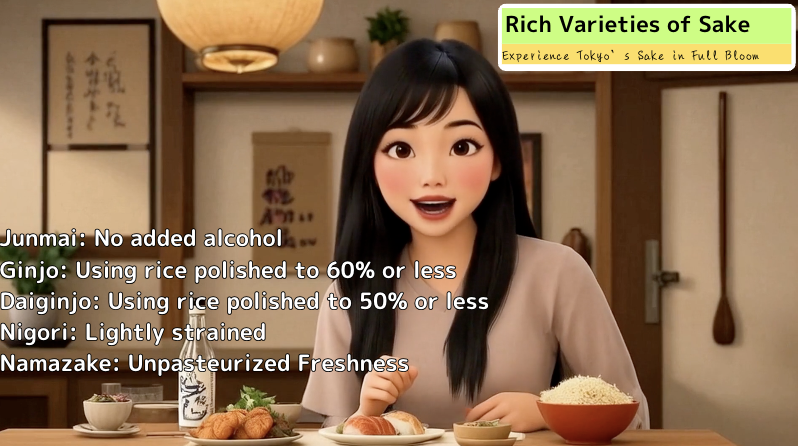
Sake’s universe is vast, shaped by the choice of rice, water, koji, and fermentation techniques. Here are five notable types—Junmai, Ginjo, Daiginjo, Nigori, and Namazake—each with its own character and craftsmanship.
Junmai: A Pure, Full-Bodied Classic
Junmai sake contains only rice, rice koji, and water, with no added alcohol. This approach yields minimal impurities and accentuates the natural sweetness and toasty flavors inherent in the rice. Junmai typically presents a mild, rounded mouthfeel that transforms significantly based on serving temperature.
Chilled, it offers a crisp sensation, while gently warmed, it reveals a deep, comforting richness. Because of this adaptability, Junmai pairs well with a wide range of foods and appeals to novices and connoisseurs alike.
Ginjo: Fragrant and Fruity Premium Sake
Ginjo sake is produced using rice polished to 60% or less of its original size and fermented slowly at low temperatures—an approach called “ginjo-zukuri.”
Extended low-temperature fermentation produces a fragrant aroma (ginjo-ka) reminiscent of melon, apple, or pear, making Ginjo sake elegant, light, and clean on the palate. Best enjoyed chilled, Ginjo is often served in wine glasses to emphasize its fruity bouquet, and its refined flair has also garnered praise among overseas sommeliers.
Daiginjo: The Pinnacle of Rice Polishing
Daiginjo is the highest grade of Ginjo sake, relying on rice polished to 50% or less—sometimes reaching 35% or even 23%.
The rigorous polishing process removes impurities, resulting in a pure, crystalline flavor and a particularly exquisite ginjo aroma.
Daiginjo often delights with a soft sweetness reminiscent of fully ripened fruit, and a clear, delicate finish. This painstaking process usually makes Daiginjo pricier, yet it rewards you with an extraordinary drinking experience.
Nigori: Velvety, Cloudy Depth
Unlike standard sake, which is meticulously filtered for clarity, Nigori sake is only lightly strained, leaving a portion of the rice solids in the liquid.
This creates a white, cloudy appearance and a luxuriously thick texture. Nigori typically tastes creamier and sweeter than other varieties, offering a natural richness that can be slightly sparkling in certain bottles.
Many sake newcomers find it approachable for its mellow sweetness and smooth mouthfeel. Nigori is also a fun option for dessert or pairing with sweet-savory dishes.
Namazake: Unpasteurized Freshness
Most sake is pasteurized twice—once before bottling, then after—to stabilize the product. Namazake (unpasteurized sake) skips this heat treatment, preserving the live enzymes and yeast. It delivers an intensely fresh, juicy character that can sometimes tingle with gentle carbonation upon opening.
The vibrant fragrance and youthful complexity often surprise those expecting a more muted flavor profile. Because Namazake is more susceptible to spoilage, it needs refrigeration and should be consumed promptly once opened. In spring, you’ll often see “shiboritate” (fresh-pressed) Namazake, bursting with the essence of the new brewing season.
Why Sake Complements Japanese Cuisine So Well
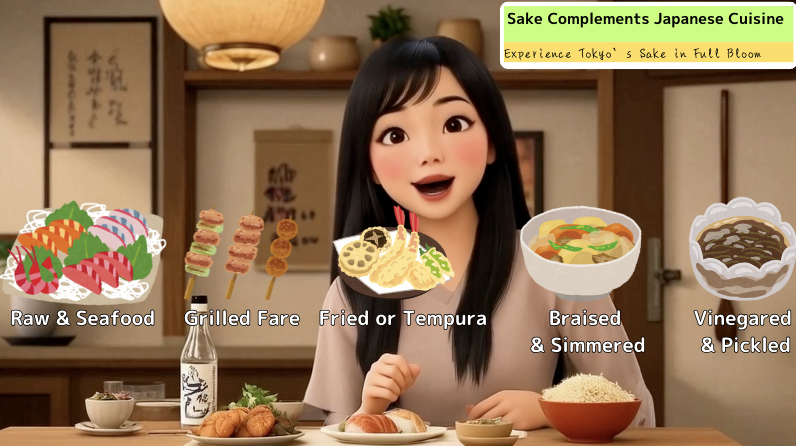
Sake is renowned worldwide for harmonizing perfectly with Japanese cuisine.
Its inviting “umami,” subtle acidity, and spectrum of aromas enhance the delicate flavors of various dishes. Below are a few familiar categories of Japanese food and how sake works its magic.
Raw & Seafood Dishes
Fresh seafood finds an elegant companion in sake’s clarity and restraint.
Japanese sake won’t overwhelm the gentle sweetness of fish, but rather refreshes the palate between bites.
Junmai, with its pronounced rice notes, can boost the richness of fatty fish, while lighter styles cleanse the palate for the next mouthful.
Grilled Fare
Grilling methods—such as charcoal-seared yakitori—create flavorsome char and melting fats in the food.
Sake’s subtle sourness and umami help balance these elements.
The mild sweetness from rice koji soothes any heaviness, while the smoky aromas of grilled items enrich the sake’s own nuanced flavors.
Fried or Tempura Dishes
Crisp tempura or fried dishes benefit from clean-finishing sake styles. The mild acidity gently cuts through oils, refreshing your taste buds for the next bite.
When heated, the soft warmth of sake further melds with the toasted notes in fried batter, leading to a pleasantly rounded aftertaste.
Braised & Simmered Meals
From hearty miso stew to simple vegetable simmered dishes, sake interweaves its umami with the deeper flavors of the broth.
Salty or sweet-tinged sauces meld smoothly with sake’s natural depth. Rather than competing, the sake’s underlying richness underlines the comforting nature of slow-cooked Japanese dishes.
Vinegared & Pickled Foods
Common in Japanese dining, pickles and vinegared dishes deliver a refreshing sour snap.
Sake provides a complementary, lactic-acid-based tartness, preventing either element from clashing. It effectively “resets” the mouth between richer courses and leaves a crisp finish.
Celebrated Sake Brands and Brewers Worldwide
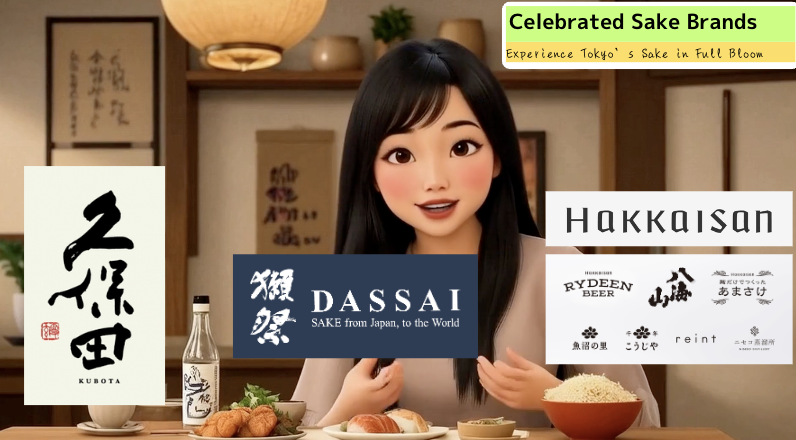
Sake’s craftsmanship and diversity have gained global recognition. Yamaguchi Prefecture’s “Dassai” exemplifies extreme rice-polishing, resulting in a refined, fruity taste served at top restaurants around the globe.
Niigata Prefecture’s “Kubota” and “Hakkaisan” are also popular overseas, offering a clean, well-balanced style that pairs beautifully with various cuisines.
Names like Akita’s “Aramasa,” Ishikawa’s “Tengumai,” and Kochi’s “Suigei” add regional flair to the international roster. Many brands continue to thrive on the world stage, winning awards at global beverage competitions.
While preserving centuries of tradition, these innovative breweries refine their processes for modern palates, ensuring that sake’s reputation grows across borders.
Enjoying Sake in Tokyo: Recommended Spots
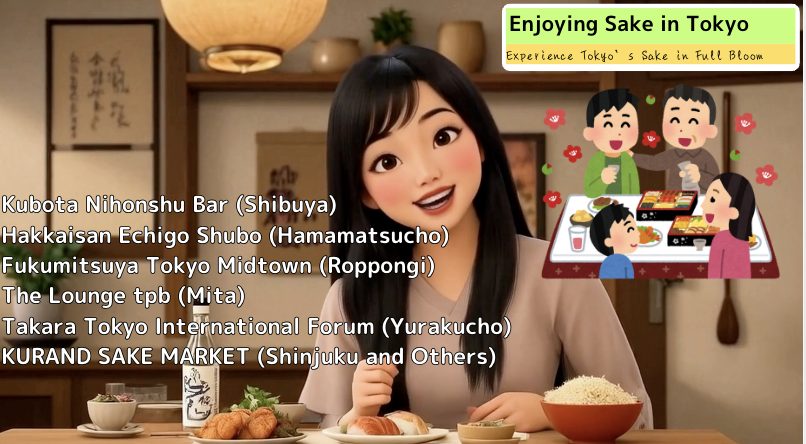
Tokyo brims with cherry trees and unique sake venues.
Below are some notable places—especially those associated with breweries or with a strong commitment to sake—where you can celebrate spring’s blossoms while exploring the world of Japan’s national drink.
Kubota Nihonshu Bar (Shibuya)
This contemporary bar showcases Niigata’s beloved “Kubota,” produced by Asahi Shuzo. In a sleek, modern interior, you can sample everything from classic labels to seasonal specialties.
Attentive staff will guide you through the different sake profiles, ensuring an accessible experience for newcomers. Located in Tokyo’s youthful and trendy district, it’s a fresh take on the sake scene.
Hakkaisan Echigo Shubo (Hamamatsucho)
A must for fans of Niigata’s signature brand, “Hakkaisan.” Here you can savor a range of labels, including limited-edition creations made available only at directly affiliated spots.
The serene, traditional setting provides an escape from the city rush—allowing you to fully appreciate the clean, elegant flavors characteristic of Hakkaisan.
Fukumitsuya Tokyo Midtown (Roppongi)
Founded in Kanazawa, Fukumitsuya is one of the region’s oldest breweries devoted to Junmai sake.
At this sleek Tokyo Midtown location, you can sample various Fukumitsuya offerings and even explore sweets and skincare items made from by-products of sake brewing.
It’s a modern “fermentation wonderland” that appeals to more than just sake lovers.
The Lounge tpb (Mita)
An intimate sake lounge produced by Tokyo Port Brewery (Tokyo Kuramoto), tpb is an ideal hideaway for indulging in pairing menus of sake and seasonal dishes.
Warm wooden accents and a calm, contemporary ambiance make it perfect for tasting premium labels tied to the brewer.
As spring arrives, you can pair special dishes featuring cherry blossoms or fresh mountain vegetables with distinctive, small-batch sake—an unforgettable urban retreat.
Takara Tokyo International Forum (Yurakucho)
Within the expansive Tokyo International Forum, this “Takara” outlet is a great place to sample various sakes from around Japan, often via tasting sets. It attracts many international guests, creating a cosmopolitan atmosphere for exploring sake.
You might even stumble upon a special event or limited-release fair, depending on your timing. Its convenient location near shops and landmarks means it’s easy to drop by between sightseeing stops.
KURAND SAKE MARKET (Shinjuku and Others)
A casual, standing bar concept that offers unlimited tasting of over 100 different sakes, stored in refrigerators you’re free to open and pour from. While the selection of drinks is massive, food is generally brought in or ordered from outside, so be sure to check their website beforehand for specific guidelines.
KURAND’s sociable environment welcomes guests from around the world, making it a lively place to discover new flavors and interact with fellow sake enthusiasts.
Conclusion: Embrace Sake Amid the Cherry Blossoms

Alongside Tokyo’s iconic sakura, a vast world of sake awaits your discovery.
Steeped in ancient worship, integrated into everyday life, and celebrated worldwide today, sake’s centuries of refinement culminate in each sip.
Learning even a little about its history, production, and pairing can transform every cup into a new revelation.
This spring, why not immerse yourself in that special delight?
The aroma of cherry blossoms, combined with the artisanal elegance of rice and water, promises to create travel memories you’ll cherish.
Let Tokyo’s springtime magic guide you through the depths of Japan’s famed drink—may your hanami season be all the richer for it!
